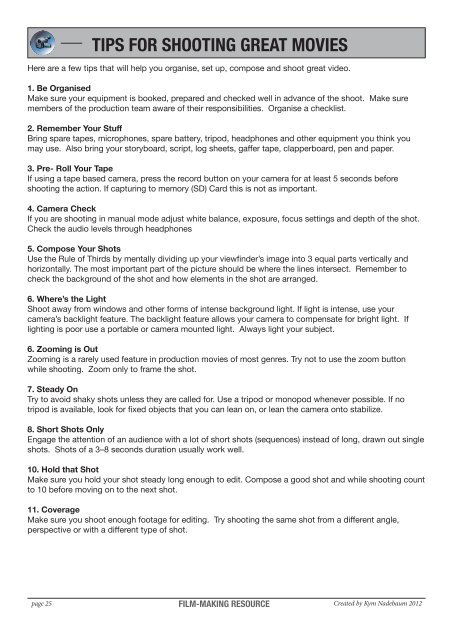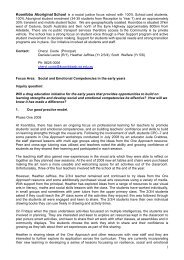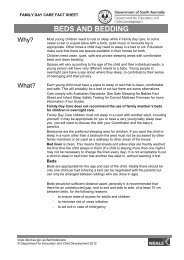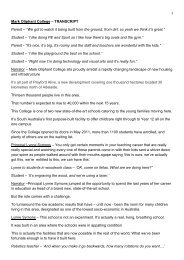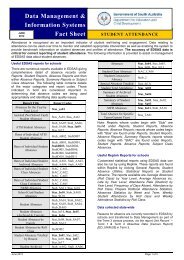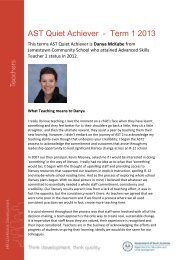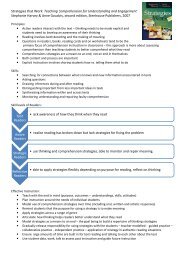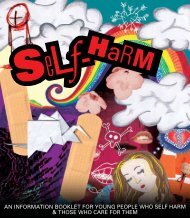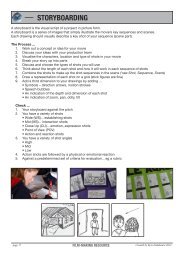Tips for shooting great movies (PDF, 559KB)
Tips for shooting great movies (PDF, 559KB)
Tips for shooting great movies (PDF, 559KB)
You also want an ePaper? Increase the reach of your titles
YUMPU automatically turns print PDFs into web optimized ePapers that Google loves.
page 25<br />
TIPS FOR SHOOTING GREAT MOVIES<br />
Here are a few tips that will help you organise, set up, compose and shoot <strong>great</strong> video.<br />
1. Be Organised<br />
Make sure your equipment is booked, prepared and checked well in advance of the shoot. Make sure<br />
members of the production team aware of their responsibilities. Organise a checklist.<br />
2. Remember Your Stuff<br />
Bring spare tapes, microphones, spare battery, tripod, headphones and other equipment you think you<br />
may use. Also bring your storyboard, script, log sheets, gaffer tape, clapperboard, pen and paper.<br />
3. Pre- Roll Your Tape<br />
If using a tape based camera, press the record button on your camera <strong>for</strong> at least 5 seconds be<strong>for</strong>e<br />
<strong>shooting</strong> the action. If capturing to memory (SD) Card this is not as important.<br />
4. Camera Check<br />
If you are <strong>shooting</strong> in manual mode adjust white balance, exposure, focus settings and depth of the shot.<br />
Check the audio levels through headphones<br />
5. Compose Your Shots<br />
Use the Rule of Thirds by mentally dividing up your viewfinder’s image into 3 equal parts vertically and<br />
horizontally. The most important part of the picture should be where the lines intersect. Remember to<br />
check the background of the shot and how elements in the shot are arranged.<br />
6. Where’s the Light<br />
Shoot away from windows and other <strong>for</strong>ms of intense background light. If light is intense, use your<br />
camera’s backlight feature. The backlight feature allows your camera to compensate <strong>for</strong> bright light. If<br />
lighting is poor use a portable or camera mounted light. Always light your subject.<br />
6. Zooming is Out<br />
Zooming is a rarely used feature in production <strong>movies</strong> of most genres. Try not to use the zoom button<br />
while <strong>shooting</strong>. Zoom only to frame the shot.<br />
7. Steady On<br />
Try to avoid shaky shots unless they are called <strong>for</strong>. Use a tripod or monopod whenever possible. If no<br />
tripod is available, look <strong>for</strong> fixed objects that you can lean on, or lean the camera onto stabilize.<br />
8. Short Shots Only<br />
Engage the attention of an audience with a lot of short shots (sequences) instead of long, drawn out single<br />
shots. Shots of a 3–8 seconds duration usually work well.<br />
10. Hold that Shot<br />
Make sure you hold your shot steady long enough to edit. Compose a good shot and while <strong>shooting</strong> count<br />
to 10 be<strong>for</strong>e moving on to the next shot.<br />
11. Coverage<br />
Make sure you shoot enough footage <strong>for</strong> editing. Try <strong>shooting</strong> the same shot from a different angle,<br />
perspective or with a different type of shot.<br />
FILM-MAKING RESOURCE<br />
Created by Kym Nadebaum 2012
page 26<br />
TIPS FOR SHOOTING GREAT MOVIES (cont)<br />
12. Shot Variety<br />
When <strong>shooting</strong> video, get plenty of A-roll (main event shots) and B-roll footage (fill or cut away shots). If a<br />
<strong>shooting</strong> a sports day story as well as <strong>shooting</strong> each event, get shots of crowd reaction, the starter’s gun,<br />
preparing <strong>for</strong> an event, presentations etc.<br />
13. Watch Your Angle<br />
Take your shots from a variety of angles. Experiment by <strong>shooting</strong> from high and low angles. Try to avoid<br />
<strong>shooting</strong> all your shots from ‘front on’ and from eye level. Try to get perspective into your shots.<br />
14. Create Some Interest<br />
Try shoots that are different and creative. Experiment by <strong>shooting</strong> the reflection in a pond or mirror. Shoot<br />
from a moving car. Shoot from inside a dark room the action taking place outside an open door in bright<br />
light. Shoot ‘walking feet’ from ground level. Shoot lots of POV (Point of View Shots).<br />
15. Move It<br />
Moving with the camera while <strong>shooting</strong> can be very powerful. Follow a conversation taking place; a<br />
person walking; or move towards or away from a subject to create depth. Experiment by moving with<br />
the camera <strong>for</strong> POV and subjective shots. Use a dolly, wheelchair, skate-board or cushion to steady the<br />
camera while moving. Take care while <strong>shooting</strong>!<br />
16. Action and Reaction<br />
Where characters are involved action shots should be followed by reaction shots. If <strong>shooting</strong> a wide action<br />
shot of a person running and he/ she is becoming exhausted, shoot a close up reaction shot of their face<br />
panting.<br />
17. Establish the Setting<br />
An audience needs to connect with where the action (story) is taking place. Use establishing (wide, long)<br />
shots to verify a location. This can also be done with ‘on screen’ text during editing.<br />
18. Connect the Start and Finish<br />
Good stories often connect the beginning and end (either with a location or a statement or question). In<br />
some <strong>movies</strong>, we see a setting shot that is repeated at the end of the movie as a cap-off. This often works<br />
well in any video, particularly with short stories, commercials or documentaries.<br />
19. Listen<br />
Always wear headphones to monitor audio input level while <strong>shooting</strong> particularly <strong>for</strong> ambient and<br />
background sound and conversation shots. Use an external microphone where ever possible.<br />
20. Talk About It<br />
Communication is a key component of a successful production. Discuss in your production team issues<br />
such as shot type, location, framing, genre, mood and message. Also discuss new ideas that may arise.<br />
FILM-MAKING RESOURCE<br />
Created by Kym Nadebaum 2012


